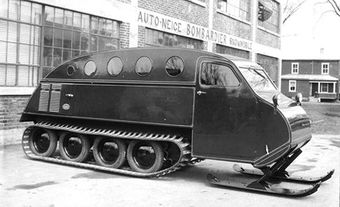A snow blower is a mechanical device that clears snow from a surface by collecting it and forcibly throwing it to another location. It was invented in Quebec by Arthur Sicard in 1925. Snow blowers typically use an auger — a corkscrew-shaped blade made of metal, rubber or plastic — to collect and then distribute snow. Some snow blowers, known as two-stage snow blowers, also feature a collecting chamber and impeller to make it easier to clear large deposits of snow. These powerful machines help keep streets, sidewalks and driveways clear during winter.

Early Models
The first device that resembled a modern snow blower was the rotary snowplough. These were intended for use on trains, in situations where the snow was too deep to be cleared by conventional snowploughs. J.W. Elliot, a dentist from Toronto, patented the first rotary snowplough in 1870, although no machines were ever built using his design. Robert Carr Harris from Dalhousie, New Brunswick patented a similar “Railway Screw Snow Excavator” in 1870, although it’s unclear if a model was ever produced. In 1884, Orange Jull of Orangeville, Ontario patented an improved version of Elliot’s rotary snowplough. It featured two large, rotating fan blades that would churn through and expel snow through a chute on the side (a later version reduced it to one blade). Jull sold the patent for this machine to Dufferin County brothers Edward and John S. Leslie. The machine was commercially available in the late-1880s.
Arthur Sicard Invents Snow Blower
In 1894, Arthur Sicard (born 17 December 1876 in Saint-Léonard-de-Port-Maurice, Quebec) witnessed a grain thresher at work in a wheat field and began to wonder if a similar device could be used to clear snow. Sicard worked for his father, a dairy farmer, and was initially interested in making milk deliveries easier during the winter. Sicard worked on his device for over 30 years. In 1925, he completed his first machine and called it “la déneigeuse et souffleuse à neige Sicard,” or the “Sicard Snow Remover Snow Blower.” Attached to the front of a truck, the Sicard snow blower featured a scooper with an auger-like device and a fan capable of blowing snow about 27 m away.
Sicard’s sold his first snow blowers to the cities of Outrement and Montreal in 1927. His design proved effective, and became popular particularly as the rise of the automobile demanded more effective methods of snow clearing. When Sicard died on 13 September 1946, he was hailed as a genius who changed the city’s relationship with winter. Montreal’s Rue Sicard, two streets over from the factory where he built his snow blower, was named in his honour.
Modern Snow Blowers
The first person-powered snow blower was made by William P. Murphy Jr., a high school student from Boston. Murphy later made a smaller version of a train-based rotary snowplough. Murphy sold his design to a lawnmower company for $1,500, though it did not become a widespread commercial product. (Murphy went on to design medical equipment, including a type of pacemaker and an artificial kidney.)
The first commercially successful personal snow blowers were introduced by Toro, an American lawncare machine company, in 1952. Called the “Snowhound,” they resembled a much smaller version of the blower Sicard attached to trucks, and were capable of clearing snow as high as one foot. Though commercial snow blowers have used different materials and become more powerful, their basic design has remained largely the same.
In the early 1960s, some railways began experimenting with snow blowers powered by jet engines, which simultaneously melt and blow away snow. Some places, such as the Soviet Union, used decommissioned engines from military jets, while the New York Central Railroad Company and the Canadian National Railway had purpose-built jets that attached to locomotive engines. Though jet engines are too expensive to be used on streets or sidewalks, they are still frequently used around the world for clearing train tracks and airport runways.

 Share on Facebook
Share on Facebook Share on X
Share on X Share by Email
Share by Email Share on Google Classroom
Share on Google Classroom



